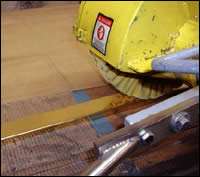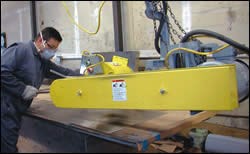Conveying Luxury in Polished Metal
How one shop produces architectural pieces with jewel-like finishes
You may not have heard of Architectural Fabrications Inc. (AFI), but you’ve no doubt heard of many of its customers. The company’s polished architectural products lend an air of opulence and sophistication to the storefronts of some of the world’s most glamorous retailers—Tiffany & Co., Gucci, Cartier and Prada, to name just a few.
These high-end retailers work hard to cultivate an image of elegance and luxury, and facades of their stores in cities around the world reflect that image. A specialty metal fabrication company located in Auburn, WA, AFI supplies highly polished stainless steel, brass, bronze, copper and aluminum architectural components including custom-made flashings, trims, closures, column covers and panels to complement the installation of windows and curtainwall systems, as well as cladding systems and custom-fabricated entries for the exclusive retailers mentioned above. Another product line is specialty stainless steel trim and other fabrications for marine applications.
Featured Content
Fabrication Process
The company operates out of a 12,000 sq ft main facility in Auburn, where 15 workers use two 12-ft press brakes, two shears, a pair of vertical milling machines, multiple TIG and MIG welding stations and numerous saws and cutting machines to fabricate custom architectural components. At some point—often both before and after fabrication—all the work makes its way through Architectural Finishing LLC, a division of AFI housed in a 3,600-sq ft shop.
According to Tim Lewis, general manager of Architectural Finishing LLC, his four employees usually prefinish material before it works its way through AFI’s fabrication process. “Normally the fab shop sends us the material prior to fabrication so that we can get the required finish onto the material,” Lewis explains. “Then it goes back to the fab shop for shearing, bending, welding and other operations. It comes back to us for grinding and polishing of the welds and repair of any damage sustained at the fab shop.
“We prefinish because parts generally end up either just too large for us to polish, or they are fabricated with the grain needing to be changed so that it all runs the proper direction. Nine times out of ten it’s best to prefinish the material,” he says.
An example of components that are prefinished is trim parts for storefront windows, retail glass counters and other applications.
“These all are pre-polished to a mirror finish, then drilled and fastened to the side of the framework that holds the glass,” Lewis explains.
Initial Finishing
AFI’s finishing division produces a wide variety of finishes on architectural and marine components. “We produce #4 brushed finishes, #6 light sand with buff, #8 mirror polish and all different colors of patina on brass or bronze,” he says. “Most of our work is with stainless, but we do also do a considerable amount of brass, which can receive the patina finish or be left polished or grained.”
Most of the company’s architectural components are fabricated from Type 304 stainless, while marine components—bow plates, anchor pockets, and other trim pieces for commercial ships and large yachts—are usually produced using Type 316L stainless steel for improved corrosion resistance.
The company also produces aluminum products in a variety of paint and anodized finishes, but many components, regardless of work material, are mechanically finished to produce a brushed, non-directional or polished appearance. Aged or patinated finishes, with or without protective clear coats, and plated finishes are also available.
According to Lewis, AFI’s finishing shop stays busy and turnaround times vary.
“Turnaround really depends on the scope of the project,” he says. “We have a pretty much constant flow of components being produced for stores for our high-end retail customers.”
Lewis says achieving the #8 mirror finish required for high-quality stainless steel architectural and marine components requires not only multiple processing steps but also some specialized equipment.
The process starts with sanding. “The stainless steel must be sanded smooth before using the buffer to apply the final polished finish,” he says. “You can’t just start polishing on a raw piece of stainless. You have to go through all the initial sanding steps.”
For this step, the company uses what Lewis calls stroke sanders. “The way it works is, you have a long sanding belt—ours is 6 × 500 inches,” he explains. “The drive machine is at one end and an idler wheel is at the other end, and the operator adjusts belt tension at the idler wheel. The idler wheel has an air piston connected to it that allows easy changing of abrasive belts, which are approximately 2.5–3 ft off the ground.”
Under the belt are two tracks running the opposite direction of the belt that support a table that glides back and forth under the belt. “Operators place a workpiece on the table and adjust it so it’s right beneath the belt, then turn the machine on and glide the table back and forth under the spinning belt,” Lewis says. “They apply downward pressure to the back of the belt with a work shoe, which is as wide as the belt and about 10 inches long. As they glide back and forth this sands the piece, getting rid of all pits and scratches. They start with a somewhat coarse paper—normally 80-grit, then follow that with 150-grit and finish with 240-grit.”
Buffing and Polishing
Like the sanding operation, buffing and polishing are also accomplished on special machines, in this case two swing-frame buffers built by Grinding & Polishing Machinery Corp. (G&P; Indianapolis, IN). Powered by 10-hp, 1800-rpm motors with guarded V-belt drives that provide a 2400-rpm spindle speed, the machines can accept buffing wheels up to 14 inches in diameter and 4 inches wide.
Featuring a swivel motion that can be left free or locked in place as needed, the machines differ only in the length from the wheel shaft to the motor shaft: one has a reach of approximately 39 inches while the other measures approximately 50 inches.
According to Lewis, the finishing shop was pretty much built around the buffing and polishing machines, which allow operators to feed polishing compound and move easily across large areas of work. “We have never been without these machines from day one,” he says. “We designed the shop around them, and we knew these were the machines we needed to achieve the results and quality our customers expect.”
Buffing and polishing is a multi-step process that begins with a sisal buff and a fairly coarse black compound that’s used to remove sanding marks. Operators move back and forth across the workpiece to remove sanding lines.
“Once the abrasive belt lines are removed, the operator can go to the next buffing step,” Lewis says. “This is done with an airflow buff and a medium compound, again going over the entire part until the initial buff lines are removed.”
The final buffing process, called color buffing, is accomplished using an airflow buff and a very fine compound. “This final step removes any remaining lines in the part, and you are usually left with a brilliant, mirror-like finish,” Lewis explains. If there are any buffing lines left at this point, they are removed using either a brand new set of buffs or by using a rake to clean the buffs and then switching to a finer compound such as jeweler’s rouge, he adds.
According to Lewis, many of the parts the company processes are flat and lend themselves well to polishing with this type of equipment. “Some of the larger, flat parts would be difficult to polish uniformly with typical hand buffers,” he says.
For more information on buffing, polishing and other finishing machines and accessories from Grinding & Polishing Machinery Corp. (Indianapolis), phone 317-898-0750 or visit www.pfonline.com.





















